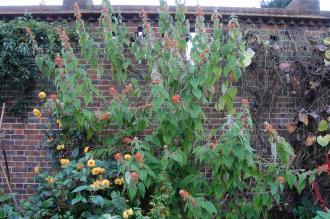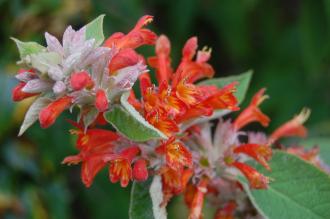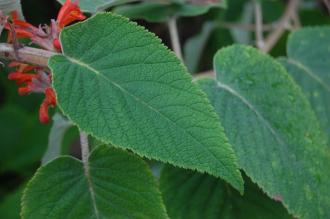
Colquhounia coccinea (08/11/2015, Kew Gardens, London)
Position: Full sun
Flowering period: Late summer to autumn
Soil: Moist, well drained
Eventual Height: 2.5m
Eventual Spread: 2.5m
Hardiness: 8b, 9a, 9b, 10a
Family: Lamiaceae
Colquhounia coccinea is an evergreen shrub with a bushy habit. Its mid to blue/ green leaves are ovate to lanceolate with serrulate margins, up to 11cm long and 5cm across. Its leaves are aromatic when crushed. Its orange flowers are up to 25mm long and appear in whorls on terminal spikes.

Colquhounia coccinea Flower (08/11/2015, Kew Gardens, London)
Colquhounia coccinea, commonly known as Scarlet Flowered Colquhounia or Himalayan Mint Plant, is native to the west China region, including Nepal, Myanmar and Thailand. In its native habitat it grows on stony, grassy hillsides and thickets.
The etymological root of the binomial name Colquhounia is named after Sir Robert Colquhoun (? – 1838), a plant collector and patron of the Calcutta Botanical Gardens. Coccinea is from the Latin meaning ‘of scarlet colour’, in reference to the color of the flower.
The landscape architect may find Colquhounia coccinea useful as an attractice autumn flowering shrub. This plant prefers a sheltered position.

Colquhounia coccinea Leaf (08/11/2015, Kew Gardens, London)
Ecologically, Colquhounia coccinea flowers are attractive to pollinating insects.
Colquhounia coccinea prefers moist, fertile, well-drained soils. It tolerates most pH of soil. This shrub dislikes wet soils.
Colquhounia coccinea requires little maintenance. This shrub may be pruned hard to encourage a compact habit.

Landscape Architecture

